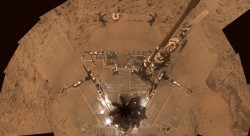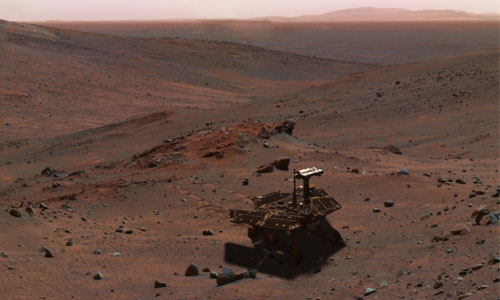[/caption]Last week, Mars Exploration Rover Spirit looked as if its sols were numbered. Hot on the heals of the demise of the frozen Phoenix lander, Spirit was about to succumb to a low-energy death brought on by a dust storm. The build-up of dust on the rover’s solar panels were already causing a serious problem, but as a storm raged over Gusev Crater, power output from the panels slumped to an all-time low. As Nancy reported on November 11th, mission controllers were forced to switch Spirit into a low-energy state, leaving them with no other choice but to command the robot to be silent. Although tensions were high, Spirit broke the silence last Thursday.
Now NASA controllers are working hard to manage Spirit’s power production, hopefully extending the life of the highly successful rover longer still…
At its worst, Spirit’s solar panels were outputting 89 watt hours of energy just before NASA mission control took decisive action by shutting down non-essential heaters on the rover. Before the storm, Spirit was already covered in a thick layer of dust from nearly five years of Mars roving, allowing only 33% of the sunlight falling on the panels to be used by the photovoltaic cells. During the storm, the dust situation had worsened, valuable sunlight was getting blocked by atmospheric dust clouds. Spirit was in trouble.

“Spirit is not out of the woods yet,” said Mars Exploration Rover (MER) Project Manager John Callas at NASA’s Jet Propulsion Laboratory. “The storm and all its dust have not gone away completely. And this is the time of the Martian year when storms like this can occur. So the plan ahead is to stay cautious with the rover and work on recharging the batteries while waiting out the rest of the storm’s activity.”
So, Spirit has been put on a low energy consumption diet. On Friday commands were sent to the rover to keep some of its heaters switched off and to conduct limited observations and communications. Spirit will be on a “go-slow” until the end of the month to give it some time to recover, recharge and be prepared in the event of a follow-up Gusev Crater storm.
At the end of the month no commands will be sent from Earth for a period of two weeks, as the Sun will be blocking the line of sight with Mars. Therefore Spirit will have lots of time to recover from the dust storm ordeal until communications between Earth and Mars return. After this period, NASA plans to move Spirit from its current location inside Gusev Crater (a low platform called “Home Plate”) so it can continue to explore the Red Planet (assuming there are no more damaging storms ahead).
Although this is all a huge relief, I can’t help but think that Spirit is on borrowed time.
Source: NASA


I have no doubt spirit will hang in there until the next dust devil comes along and sweeps off its solar panels.
Long live our beloved rovers.
++
What Neil said!!
I remember sometime ago a twister had cleared the dust off on one of the rover solar panels. Hope it happen again to clear the panels without more dust getting onto it.
I swear they need little windscreen-wipers when they send a craft with solar panels up, or a little blower fan or something. I know they weren’t expecting dust to be an issue over the predicted lifetime of the craft, but surely it would be a relatively simple addition.
In fact, solar panels can bugger off all together as far as space exploration is concerned – all craft should be running with RTGs.
Hrm…didn’t the rovers sort of unfold their solar arrays in the beginning? I mean obviously if it were possible to fold up the panels then unfold them again to unseat some of the dust this would have been done but I recall them being hinged, wouldn’t folding them back up clean them off a little bit?
that is true what silver thread said, but, one- there may not be enough power to fold and unfold the arrays, and two- you run the risk of letting the dust fall onto other parts of the rover and jam up the instruments…or the solar array hinges, either way it’s a risky move, and i don’t think we can depend on a dust devil coming to the rescue to clean it up, i think it would be best to take advantage of the borrowed time the rover is running on the best possible scientific use until the rovers demise which, at one time or another, will come.
long live MER
I have a vague memory of frost causing the dust to stick together and clearing the solar arrays in the early stages of this mission. Anybody remember that?
@Astrofiend totally agree RTGs are the way to go for future missions.
Wonder if the rock abrasion tool can be used as a small fan to clear the dust off the solar panels. After the batteries recharge of couse. I’m sure the boffins checked this already & its a dumb idea!
Go Spirit!
Never give up, never surrender!
I’m with Astrofiend.. why don’t we use RTGs
Budget issues aside must be political
From Wikipedia, the free encyclopedia
Jump to: navigation, search
A radioisotope thermoelectric generator (RTG, RITEG) is an electrical generator which obtains its power from radioactive decay. In such a device, the heat released by the decay of a suitable radioactive material is converted into electricity by the Seebeck effect using an array of thermocouples. RTGs can be considered as a type of battery and have been used as power sources in satellites, space probes and unmanned remote facilities. RTGs are usually the most desirable power source for unmanned or unmaintained situations needing a few hundred watts or less of power for durations too long for fuel cells, batteries and generators to provide economically, and in places where solar cells are not viable.
Agreed – it’s a terrible waste of potential to not have some little brushes on the panels, a little rotator on a track or central spindle, or the panels could retract or rotate under a stationary brush, or a tool on a robot arm, all good ideas. Also agree to RTG’s, this solar stuff is some kind of silly idealistic throwback. It’s a desert, all the planets are deserts, we are not harming anything. The most we can ever hope to find are microbes.
Surely the rover panels generate Watts, not Watt-Hours. Watt-Hours are what end up in the batteries. Trivial I know, but annoying to read.
Paul
According to the source (http://marsrovers.nasa.gov/newsroom/pressreleases/20081114a.html) – the panels output “Watt hours”. I’ll have to check my electrical theory to be sure, but I just assumed the NASA press release would be pretty accurate. You could be right though 🙂
Cheers, Ian